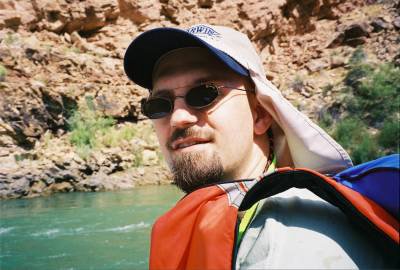Mount St. Helens and the Grand Canyon
Creationists have long pointed to the volcanic blast of Mt. St. Helens as evidence for creationism. They saw how rapidly melted snowcaps and pyroclastic ash carved a large canyon which looked like the Grand Canyon in miniature, very rapidly. Naturally, they pointed to it and said, "That's it! The Grand Canyon after Noah's flood happened just like that!"
Dr. Alan Gishlick (pictured here, about to jump from the moss-covered central spring of beautiful Elves' Chasm, located inside Grand Canyon National Park) actually went to Mount St. Helens to visit the "Mini Grand Canyon" to see what it looked like. What he found disappointed him. Instead of sharply carved canyon walls, he found a canyon which had quickly eroded into smooth-flowing hillsides with sedimentary layers all but invisible. So much for that creationist argument!
This really shouldn't surprise anyone. The canyon which was carved by the St. Helens blast in 1980 cut into material which was not very hard. Most of it was volcanic ash which had been laid down in previous eruptions long before 1980. Oh, when it was first eroded, it's sharply defined sedimentary layers must have looked impressive. But had you taken a rock hammer to them, the hammer would have gone "thud" because the sediments were soft and crumbly. Now, take that same hammer to the Grand Canyon's uppermost layers, and it will go "chink!" That's because the Grand Canyon is carved a mile deep into solid rock!
The notion that a single flood could have 1. laid down the sediments 2. compacted them into rock within 100 days, then 3. Carved away 900 cubic miles of material with receeding floodwater in a single gush... Well, that just strains credulity way past the breaking point.
Eric



0 Comments:
Post a Comment
<< Home